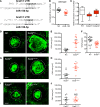Macrophage microRNA-150 promotes pathological angiogenesis as seen in age-related macular degeneration
- PMID: 29618664
- PMCID: PMC5928865
- DOI: 10.1172/jci.insight.120157
Macrophage microRNA-150 promotes pathological angiogenesis as seen in age-related macular degeneration
Abstract
Macrophage aging is pathogenic in diseases of the elderly, including age-related macular degeneration (AMD), a leading cause of blindness in older adults. However, the role of microRNAs, which modulate immune processes, in regulating macrophage dysfunction and thereby promoting age-associated diseases is underexplored. Here, we report that microRNA-150 (miR-150) coordinates transcriptomic changes in aged murine macrophages, especially those associated with aberrant lipid trafficking and metabolism in AMD pathogenesis. Molecular profiling confirmed that aged murine macrophages exhibit dysregulated ceramide and phospholipid profiles compared with young macrophages. Of translational relevance, upregulation of miR-150 in human peripheral blood mononuclear cells was also significantly associated with increased odds of AMD, even after controlling for age. Mechanistically, miR-150 directly targets stearoyl-CoA desaturase-2, which coordinates macrophage-mediated inflammation and pathologic angiogenesis, as seen in AMD, in a VEGF-independent manner. Together, our results implicate miR-150 as pathogenic in AMD and provide potentially novel molecular insights into diseases of aging.
Keywords: Aging; Macrophages; Ophthalmology.
Conflict of interest statement
Figures







References
Publication types
MeSH terms
Substances
Grants and funding
LinkOut - more resources
Full Text Sources
Other Literature Sources
Medical
Molecular Biology Databases

